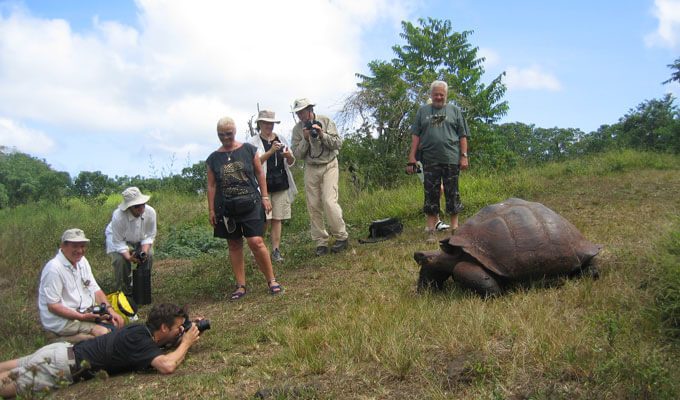The most incredible variety of Galapagos giant tortoise species may be found on Ecuador’s Galapagos Islands. Still, there is only one other location on Earth where these amazing chelonians can be found.

Nothing has baffled experts who study reptiles more than the evolution of the gigantic tortoises of the Galapagos, often known as herpetologists. According to fossil records, giant tortoises once roamed various parts of the planet, except Australia and Antarctica. They disappeared from Earth’s surface, reappearing as giants in different parts of our world. As a result, these enormous chelonians are commonly referred to as relic species.
TALK TO A DESTINATION EXPERT

Diego Zapata

Rosa Mena

Sandy Lara

Diego Zapata

Rosa Mena

Sandy Lara
DISCOVERABLE IN THE GALAPAGOS ISLANDS AND AROUND THE INDIAN OCEAN?
The Galapagos Islands are situated in the Pacific Ocean, around 1,000 kilometers off the coast of western South America. Meanwhile, many islands and atolls may be found in another remote archipelago off the coast of eastern Africa, northeast of Madagascar, and parallel to Tanzania and Kenya. The Seychelles Archipelago is located here. It was directly impacted by human activity over time, as seen by the introduction of several species and the demise of numerous native and endemic species, including giant tortoises. It was settled far earlier than the Galapagos. Giant tortoises once roamed many Seychelles islands; today, Aldabra Island is the only atoll where wild tortoises remain.
Source: Incredible World
When visiting the Galapagos Islands, there are numerous opportunities to witness giant tortoises in semi-natural and wild settings. You can observe them from the time they are breeding and hatching until they are completely grown. The primary distinction is that in contrast to Seychelles, the Galapagos Islands still have giant tortoises, and you can witness the conservation efforts made to preserve these equatorial chelonians there and on other islands in the archipelago.
DO THESE TORTOISES HAVE ANY MORPHOLOGICAL DIFFERENCES?
Most people will find it difficult to distinguish between the two species of tortoises—giant and others—if they are placed in front of them. However, if you use your keen observational skills, as Charles Darwin did on the Beagle, you will begin to notice some intriguing characteristics. Their shell, often called the carapace, may be the most straightforward distinction to notice. Scutes are those big, jigsaw-like pieces; they are dermal plates, just like our nails, but comprised of keratin. The sternum, vertebrae, and joined ribs make up the bone skeleton of the shell, which is covered in these plates. To put it another way, they are fully equipped with armor.
Source: Yacht Isabela II
THE GIANT TORTOISES OF GALAPAGOS VS THE ALDABRA TORTOISES
Examine the frontal edge of the carapace. Just beneath the tortoise’s emerging neck, you can see that one shell has an additional piece on it. This extra shell is known as the nuchal plate. Galapagos tortoises do not have this other plate, but Aldabra, like gigantic tortoises, have. This is better illustrated in the illustrations. In contrast to the Galapagos tortoise, which has a more square-shaped skull, the Aldabra tortoise appears to have a little rounder head. These are only a few of the more apparent variations.
There are more Aldabra tortoises found in captivity than Galapagos giant tortoises, even though Galapagos tortoises are frequently avidly displayed at zoos worldwide. There is nothing like witnessing a massive tortoise in its native habitat, even though these exhibits may pique your curiosity about visiting a specific location.
With just 40 spaces available, the Yacht Isabela II allows travelers worldwide to see the Galapagos Islands. Three distinct itineraries cover the various regions of the archipelago, and each offers the opportunity to visit many of the renowned BIG15 species of the archipelago in addition to the Galapagos giant tortoises.
Take advantage of the incredible moments with the famous Galapagos fauna!

Javier Garcia

Eduardo Silva

Carolina Escobar
START PLANNING YOUR TRIP

Javier Garcia

Eduardo Silva

Carolina Escobar
Get in touch for more
CONTACT US
Francisco Dousdebés – Galapagos Expert, Quito, April 30th, 2016 – 0°39’S / 91°22’W




